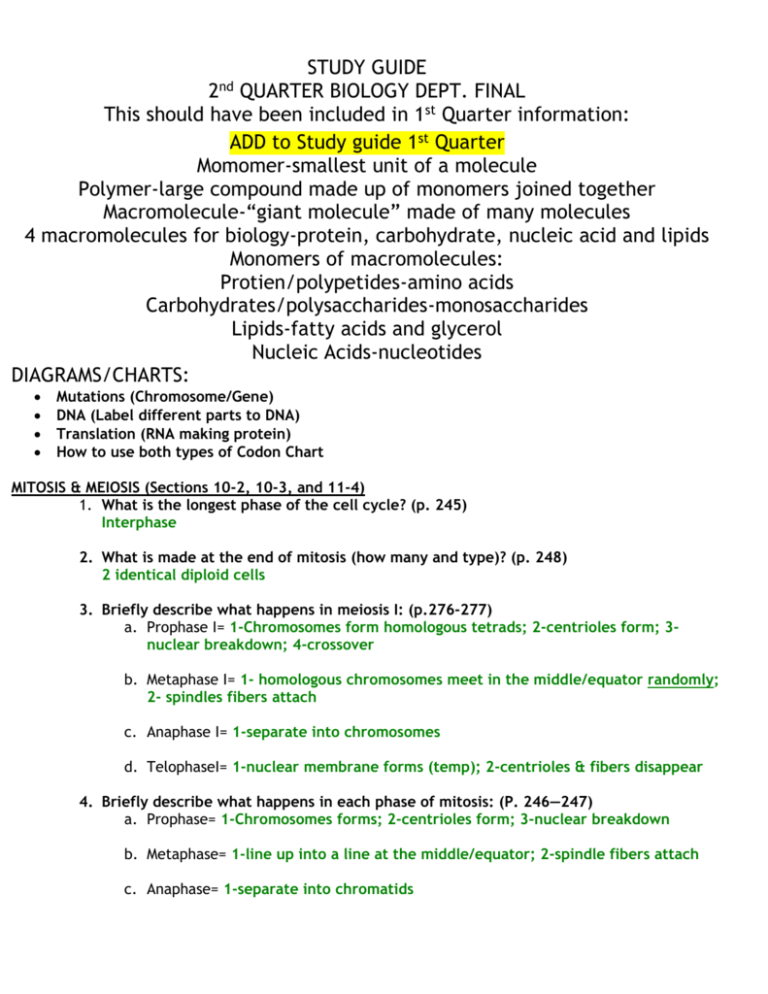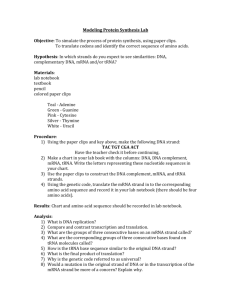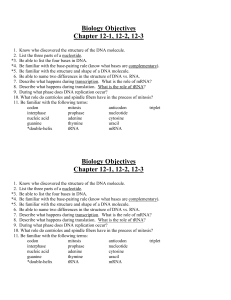STUDY GUIDE - Cloudfront.net
advertisement

STUDY GUIDE 2nd QUARTER BIOLOGY DEPT. FINAL This should have been included in 1st Quarter information: ADD to Study guide 1st Quarter Momomer-smallest unit of a molecule Polymer-large compound made up of monomers joined together Macromolecule-“giant molecule” made of many molecules 4 macromolecules for biology-protein, carbohydrate, nucleic acid and lipids Monomers of macromolecules: Protien/polypetides-amino acids Carbohydrates/polysaccharides-monosaccharides Lipids-fatty acids and glycerol Nucleic Acids-nucleotides DIAGRAMS/CHARTS: Mutations (Chromosome/Gene) DNA (Label different parts to DNA) Translation (RNA making protein) How to use both types of Codon Chart MITOSIS & MEIOSIS (Sections 10-2, 10-3, and 11-4) 1. What is the longest phase of the cell cycle? (p. 245) Interphase 2. What is made at the end of mitosis (how many and type)? (p. 248) 2 identical diploid cells 3. Briefly describe what happens in meiosis I: (p.276-277) a. Prophase I= 1-Chromosomes form homologous tetrads; 2-centrioles form; 3nuclear breakdown; 4-crossover b. Metaphase I= 1- homologous chromosomes meet in the middle/equator randomly; 2- spindles fibers attach c. Anaphase I= 1-separate into chromosomes d. TelophaseI= 1-nuclear membrane forms (temp); 2-centrioles & fibers disappear 4. Briefly describe what happens in each phase of mitosis: (P. 246—247) a. Prophase= 1-Chromosomes forms; 2-centrioles form; 3-nuclear breakdown b. Metaphase= 1-line up into a line at the middle/equator; 2-spindle fibers attach c. Anaphase= 1-separate into chromatids d. Telophase= 1-nuclear membrane forms; 2-centrioles & fibers disappear 3. chromosomes unwind 5. What are the differences between mitosis and meiosisII? (notes) Meiosis-form 4 unidentical haploid gamete cells through 2 divisions Mitosis-2 identical diploid cells through 1 division 6. How many and what type of cells are produced in meiosis? (p.276) 4 nonidentical haploid gamete (eggs and sperms)cells 7. What cells and where in the body does mitosis occur (hint: somatic or sex cells)?(notes) Somatic cells-all over the body 8. What cells and where in the body does meiosis occur? (use the hint from #7) (notes) Sex cells-sex organs 9. What are gametes?(p.266) Sperm and eggs/haploid cells 10. How many chromosomes from each parent? (p. 341 & 342) 23 individual (no pairs) 11. How is a zygote produced? (p. 1009) 2 gamete cells join in fertilization 12. What two phases produce genetic diversity and what occurs? (p. 276, 277 & notes) Prophase I (crossing over) and Metaphase I (homologous tetrads lining up randomly) 13. What is the process of meiosis called in females? Males? (p. 278 & notes) Oogenesis/females & spermatogenesis/males 14. What do you call the exchange of genetic information between homologous chromosomes (prophase I)? (p. 277) Cross over Genetic Introduction Material (chapters 11, 12-4, & 14) 15. What is heredity? (notes) Passing of traits from parent to offspring 16. What is a genotype? (p. 268) Genetic make up/alleles 17. What is a phenotype? (glossary) Physical trait 18. What is an allele? (glossary) A form of the gene 19. What does heterozygous mean? (glossary) Alleles are different same as hybrid 20. What does homozygous mean? (glossary) Alleles are the same as purebred 21. What is a dominant allele and what type of letter is used?(notes) Hides all other allele traits-capital-can be seen as long as 1 allele is dominant 22. What is a recessive allele and what type of letter is used?(notes) Shows only when there are no dominant-2 lowercase alleles ONLY 23. What is a male genotype? Female?(p. 342) XY-male & XX-female DNA, RNA, & Protein Synthesis (sections 12-1 to 12-4) 24. What is the shape and components of DNA? (p. 293) Double helix (twisted ladder)-Deoxyribose & phosphate sides and 2 nucleic bases as rungs 25. What is the shape and components of mRNA? (p. 300-301) Single strand-ribose & phosphate side with a nucleic base attached 26. What is tRNA? (p. 300-301) Transfer RNA-amino acid on 1 side and Anticodon on other side-brings the amino acid to the rRNA 27. What is rRNA? (p. 300-301) Molecule forms ribosomes 28. What is the pairing of DNA nucleotides? (p.294) A-T C-G 29. What is the pairing of mRNA to DNA nucleotides? (p. 301) A-U C-G 30. What is a codon? Anticodon? (p.302-305) Codon-3 sequence section on the mRNA that is used to code for the amino acids/use chart. Anticodon-3matching nucleotides code on the tRNA with the corresponding amino acid on the other side of the tRNA 31. What is the order of protein synthesis? (p.302-306) include translation, assembly line, completing the Polypeptide, & transcription) 1.transcription; 2. translation/transfer; 3. assembly line; & 4.completion of the polypeptide chain/protein 32. What are the start and stop codons and what process do they help with? (p.302303) AUG-Start translating codon UAA, UAG, & UGA are stop translating codons 33. What is replication and where does it occur?(p. 297-299 & 246) Replication is the copying of DNA during the S phase of Interphase that occurs in the nucleus 34. What is and where does transcription occur?(p. 301 & 304-305) Transcription is the 1st step in protein synthesis where mRNA copies part of the DNA code 35. What is translation and where does it occur? (p.301-303) Translation is part of protein synthesis where mRNA is decoded at the ribosome (rRNA). The tRNA matches up its anticodons to the mRNA’s codons 36. Where in the cell and how is protein synthesized? (p. 302-306 & notes) When the tRNA matches its anticodons to the mRNA’s codons at the ribosomes, it brings with it a particular amino acid. After the tRNA’s drops off amino acids from the start to the stop codon, the protein is complete. 37. Briefly define the sequence mutations?(p. 307) a. Point mutation= occurs in a single point of the DNA. b. Frameshift mutation= The shifting of DNA nucleotides caused by an insertion or deletion 38. Are all mutations bad? (p. 308) No, some are bad, some are good, and some cause no change 39. Thymine is in DNA and replaced with uracil on the RNA strand. (p. 297-299 & 302) 40. Write the complementary strand to the strand of DNA shown under the process of REPLICATION. (p. 295) ATTCCGTCAAA T A A G G C A G T TT-------Complimentary DNA strand 41. Write the complementary strand of DNA shown under the process of TRANSCRIPTION. (p. 301-301) ATTCCGTCAAA U A A G G C A G U U U-------mRNA stand 40.








